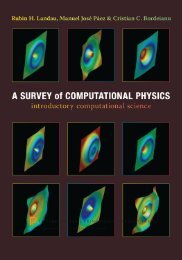- Page 8:
Preface“More is different” is a
- Page 12:
ContentsPart I General Principles1
- Page 16:
ContentsIX7 Magnetic Materials ....
- Page 24:
Part IGeneral Principles
- Page 28:
4 1 Thermal Equilibrium and the Pri
- Page 34:
1.2 Thermal Equilibrium 7environmen
- Page 38:
1.3 Kinetic Theory of Gas Molecules
- Page 42:
1.3 Kinetic Theory of Gas Molecules
- Page 46:
1.3 Kinetic Theory of Gas Molecules
- Page 50:
1.3.2 Velocity Distribution of an I
- Page 56:
18 1 Thermal Equilibrium and the Pr
- Page 60:
20 1 Thermal Equilibrium and the Pr
- Page 64:
2EntropyIn the previous chapter, we
- Page 68:
2.1 The Microcanonical Distribution
- Page 72:
2.2 Number of States and Density of
- Page 76:
2.3 Conditions for Thermal Equilibr
- Page 80:
2.3 Conditions for Thermal Equilibr
- Page 84:
2.4 Thermal Nonequilibrium and Irre
- Page 88:
36 3 The Partition Function and the
- Page 92:
38 3 The Partition Function and the
- Page 96:
40 3 The Partition Function and the
- Page 100:
42 3 The Partition Function and the
- Page 104:
44 3 The Partition Function and the
- Page 108:
4Ideal GasesHere, we shall apply st
- Page 112:
4.2 Phase Space and the Number of M
- Page 116:
4.3 Entropy of an Ideal Gas 51Fig.
- Page 120: 4.3 Entropy of an Ideal Gas 53Final
- Page 124: 4.5 Statistical-Mechanical Temperat
- Page 128: 4.6 Partition Function of an Ideal
- Page 132: 4.7 Diatomic Molecules 59Fig. 4.7.
- Page 136: 4.7 Diatomic Molecules 614.7.3 Vibr
- Page 140: 4.7 Diatomic Molecules 63Fig. 4.9.
- Page 144: 4.7 Diatomic Molecules 65Thendε=(2
- Page 148: 5The Heat Capacity of a Solid,and B
- Page 152: 5.1 Heat Capacity of a Solid I - Ei
- Page 156: 5.2 Heat Capacity of a Solid II - D
- Page 160: 5.2 Heat Capacity of a Solid II - D
- Page 164: 5.2 Heat Capacity of a Solid II - D
- Page 168: 5.3 Black-Body Radiation 77Fig. 5.7
- Page 174: 80 5 The Heat Capacity of a Solid,
- Page 178: 6The Elasticity of RubberIn this ch
- Page 182: 6.3 Entropy of Rubber 85Fig. 6.1. A
- Page 186: 6.4 Hooke’s Law 87This result rep
- Page 190: 90 7 Magnetic MaterialsTable 7.1. M
- Page 194: 92 7 Magnetic Materialsor antiparal
- Page 198: 94 7 Magnetic Materialsand( ) µBM(
- Page 202: 96 7 Magnetic MaterialsThis result
- Page 206: 98 7 Magnetic Materialslines betwee
- Page 210: 100 7 Magnetic Materialsvalue of M
- Page 214: 102 7 Magnetic MaterialsTable 7.2.
- Page 218: 104 7 Magnetic MaterialsFig. 7.8. R
- Page 222:
106 7 Magnetic MaterialsThis temper
- Page 226:
108 7 Magnetic MaterialsThus the tw
- Page 230:
110 7 Magnetic Materialsdependence
- Page 234:
Part IIIMore Advanced Topics
- Page 238:
116 8 First-Order Phase Transitions
- Page 242:
118 8 First-Order Phase Transitions
- Page 246:
120 8 First-Order Phase Transitions
- Page 250:
122 8 First-Order Phase Transitions
- Page 254:
124 8 First-Order Phase Transitions
- Page 258:
126 8 First-Order Phase Transitions
- Page 262:
128 8 First-Order Phase Transitions
- Page 266:
130 8 First-Order Phase Transitions
- Page 270:
9Second-Order Phase TransitionsBesi
- Page 274:
9.2 Landau Theory 135Every microsco
- Page 278:
9.2 Landau Theory 137⎧⎪⎨ 0 (T
- Page 282:
9.2 Landau Theory 139andU(T,V,N)=F
- Page 286:
whereand9.3 The Two-Dimensional Isi
- Page 290:
9.3 The Two-Dimensional Ising Model
- Page 294:
9.3 The Two-Dimensional Ising Model
- Page 298:
148 10 Dense Gases - Ideal Gases at
- Page 302:
150 10 Dense Gases - Ideal Gases at
- Page 306:
152 10 Dense Gases - Ideal Gases at
- Page 310:
154 10 Dense Gases - Ideal Gases at
- Page 314:
156 10 Dense Gases - Ideal Gases at
- Page 318:
158 10 Dense Gases - Ideal Gases at
- Page 322:
160 10 Dense Gases - Ideal Gases at
- Page 326:
162 10 Dense Gases - Ideal Gases at
- Page 330:
164 10 Dense Gases - Ideal Gases at
- Page 334:
166 10 Dense Gases - Ideal Gases at
- Page 338:
168 10 Dense Gases - Ideal Gases at
- Page 342:
170 10 Dense Gases - Ideal Gases at
- Page 346:
172 10 Dense Gases - Ideal Gases at
- Page 350:
174 10 Dense Gases - Ideal Gases at
- Page 354:
176 10 Dense Gases - Ideal Gases at
- Page 358:
178 10 Dense Gases - Ideal Gases at
- Page 362:
180 10 Dense Gases - Ideal Gases at
- Page 366:
Part IVAppendices
- Page 370:
186 Formulas Related to the Factori
- Page 374:
188 The Gaussian Distribution Funct
- Page 378:
190 The Gaussian Distribution Funct
- Page 382:
192 Lagrange’s Method of Undeterm
- Page 386:
194 Volume of a HypersphereNow let
- Page 390:
196 Hyperbolic FunctionsTheir deriv
- Page 394:
198 Boundary ConditionsHere n must
- Page 398:
GThe Riemann Zeta FunctionThe Riema
- Page 402:
References1. C. Seife: Science 302,
- Page 406:
206 Indexdensity of states 26diamon
- Page 410:
208 Indexsymmetry 134temperature 7,











![Práctica [PDF] - Universidad de Carabobo, FACYT - computacion](https://img.yumpu.com/48491415/1/190x245/practica-pdf-universidad-de-carabobo-facyt-computacion.jpg?quality=85)




